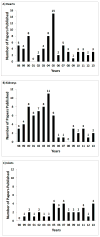Progress in pig-to-non-human primate transplantation models (1998-2013): a comprehensive review of the literature
- PMID: 25176336
- PMCID: PMC4176554
- DOI: 10.1111/xen.12127
Progress in pig-to-non-human primate transplantation models (1998-2013): a comprehensive review of the literature
Abstract
Background: The pig-to-non-human primate model is the standard choice for in vivo studies of organ and cell xenotransplantation. In 1998, Lambrigts and his colleagues surveyed the entire world literature and reported all experimental studies in this model. With the increasing number of genetically engineered pigs that have become available during the past few years, this model is being utilized ever more frequently.
Methods: We have now reviewed the literature again and have compiled the data we have been able to find for the period January 1, 1998 to December 31, 2013, a period of 16 yr.
Results: The data are presented for transplants of the heart (heterotopic and orthotopic), kidney, liver, lung, islets, neuronal cells, hepatocytes, corneas, artery patches, and skin. Heart, kidney, and, particularly, islet xenograft survival have increased significantly since 1998.
Discussion: The reasons for this are briefly discussed. A comment on the limitations of the model has been made, particularly with regard to those that will affect progression of xenotransplantation toward the clinic.
Keywords: islets; non-human primate organs; pigs; xenotransplantation.
© 2014 John Wiley & Sons A/S Published by John Wiley & Sons Ltd.
Conflict of interest statement
The authors report no conflicts of interest.
Figures
References
-
- COOPER DKC, HUMAN PA, LEXER G, et al. Effects of cyclosporine and antibody adsorption on pig cardiac xenograft survival in the baboon. J Heart Transplant. 1988;7:238–246. - PubMed
-
- LEXER G, COOPER DKC, ROSE AG, et al. Hyperacute rejection in a discordant (pig to baboon) cardiac xenograft model. J Heart Transplant. 1986;5:411–418. - PubMed
-
- LAMBRIGTS D, SACHS DH, COOPER DKC. Discordant organ xenotransplantation in primates: world experience and current status. Transplantation. 1998;66:547–561. - PubMed
-
- HARA H, COOPER DKC. The immunology of corneal xenotransplantation: a review of the literature. Xenotransplantation. 2010;17:338–349. - PubMed
Publication types
MeSH terms
Grants and funding
LinkOut - more resources
Full Text Sources
Other Literature Sources
Medical
Miscellaneous


